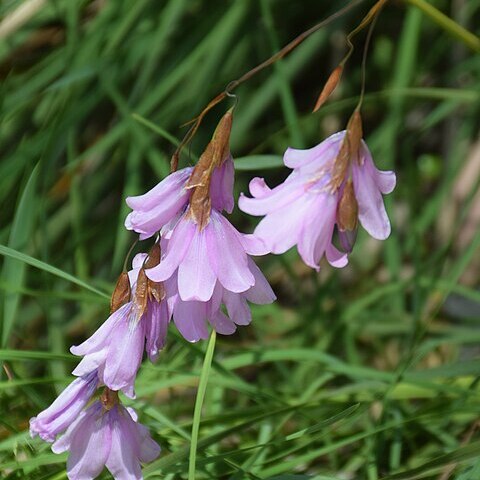Perennial herb, geophyte 0.35-0.60 m high; stems may form clumps; corm 15 mm in diam. Leaves linear, acute; radical leaves 100-400 x 1-4 mm; reduced sheathing leaves 3. Flowering stem 0.3-0.6 m high. Inflorescence a raceme of spikes; with 5 branches, pendulous, lax. Bracts bright rusty brown, 12-18 x 7-10 mm, obovate-oblong to lanceolate-elliptic, flecked. Perianth bright pink or reddish, rarely with white spots, 20-28 mm long; tube 5-7 mm long; tepals 14-22 x 4.5-8.5 mm. Anthers 5-7 mm long. Flowering time Nov.-Jan.
Spikes pendulous, the terminal spike 1–4(5)-flowered, lateral spikes 1–3(4)-flowered; flowers lax with bracts 1.5–2 internodes long; floral bracts 12–18 mm long, broadly obovate-oblong to broadly elliptic or lanceolate-elliptic, bright rust-brown and darkly flecked; main veins 6–8 on each side of the midvein, 0.25–0.5 mm apart, fading out in the upper third of the bract.
Cormous herb, up to 0.6 m high. Terminal spike with 1-4(5) flowers. Bracts bright rusty brown with 6-8 main veins each side of midvein.
Flower bright-pink to reddish (rarely white), 20–28 mm long; perianth tube 5–7 mm long; tepals 14–22 × 4.5–8.5 mm.
Leaves several, the basal ones 100–400 × 2–4 mm, sheathing cauline leaves usually 3.
Plant usually forming dense clumps, but occasionally stems solitary.
Stigmas reaching to (6)9–15 mm below the tepal apices.
Stems 30–60 cm long, simple or with up to 5 branches.
Corms c. 15 mm in diameter.
Anthers 5–7 mm long.

